Planning a low carb grocery haul but unsure what to toss into your cart? You’re not alone.
Hidden carbs sneak into everyday “healthy” foods especially those labeled low-fat or diet-friendly and can sabotage your goals fast.
This guide takes the guesswork out of your low carb shopping list.
We’ll walk through each grocery aisle and show you the smartest swaps, essential ingredients, and money-saving tips that support your low carb lifestyle without sacrificing taste or variety.
Let’s make your next keto grocery haul a success, starting with the most colorful part of the store: fresh produce.
Fresh Produce for a Low Carb Grocery Haul

Vegetables should make up a large part of any low carb grocery haul.
Focus on non-starchy picks like spinach, kale, cucumbers, zucchini, cauliflower, broccoli, and bell peppers.
These are packed with fiber and nutrients while keeping net carbs low.
Top Vegetables for Low Carb Shoppers:
- Leafy greens (spinach, arugula)
- Cruciferous veggies (broccoli, cauliflower)
- Salad-friendly options (cucumbers, bell peppers, radishes)
Fruits need a little more attention. Berries like strawberries, raspberries, and blueberries are your best bets thanks to their low sugar content.
Avocados are another must-have they’re loaded with healthy fats and fiber, making them a staple for any low carb meal prep.
Skip high-sugar fruits like bananas, mangoes, and grapes, and avoid juices or dried fruits, which often contain added sugars.
With stocking up on the right low-carb vegetables and fruits, you can easily add flavor, texture, and essential nutrients to your meals.
As important as produce is, it’s just one part of a well-rounded diet.
With the right protein choices, you’ll be able to balance out your meals and keep your energy levels up throughout the day.
Best Proteins for a Low Carb Diet
Protein is essential for a balanced low-carb lifestyle. When shopping, prioritize fresh, whole cuts of meat like chicken, turkey, pork, or grass-fed beef to keep meals clean and satisfying.
Fatty fish such as salmon, sardines, and mackerel add heart-healthy omega-3s to your weekly menu.
Eggs are another staple, affordable, versatile, and rich in protein. Rotisserie chicken is a quick and convenient pick, though it’s wise to check labels for sugary marinades.
For added variety, look into minimally processed deli meats like sliced turkey or roast beef, avoiding heavily flavored or sweetened options that sneak in carbs.
Protein is essential to keeping your low-carb meals satisfying and nutrient-dense.
With your proteins in place, the next step is to add healthy fats to your cart these fats will bring your meals to life, helping you feel full and satisfied for longer.
Low Carb Dairy and Alternatives

Dairy can support your low carb goals when chosen wisely. Full-fat cheeses like cheddar, Swiss, gouda, and parmesan are excellent choices.
Hard cheeses usually have fewer carbs than soft varieties.
For yogurt, look for unsweetened Greek yogurt with live cultures. It pairs perfectly with low carb toppings like chia seeds or fresh berries.
Milk naturally contains lactose (a sugar), so swap it out with low carb alternatives like:
- Unsweetened almond milk
- Coconut milk
- Macadamia milk
For your morning coffee, heavy cream or half-and-half work better than traditional milk without spiking carbs.
Choosing the right dairy and dairy alternatives is another key step in maintaining your low-carb lifestyle.
From here, it’s time to add healthy fats into the mix. Healthy fats will complement your proteins and keep your meals flavorful and satisfying.
Essential Healthy Fats for Low Carb Cooking
No do not fear fat, it’s your friend on a low-carb diet. Stock up on:
- Extra virgin olive oil
- Avocado oil
- Coconut oil
These oils are ideal for cooking and add depth of flavor to meals. Butter and ghee are also great low carb staples, perfect for sautéing or adding richness to dishes.
Nuts and seeds like almonds, chia, walnuts, and flaxseeds offer healthy fats and fiber. Stick to raw or dry-roasted versions without added sugars.
Avoid highly processed vegetable oils like soybean or corn oil, which offer little nutritional value.
Healthy fats are crucial for maintaining energy and flavor in a low-carb diet.
Once your fats are covered, you can turn your attention to stocking up on pantry essentials, which will provide the foundation for delicious, easy meals throughout the week.
Low Carb Pantry Staples You Should Stock
A well-stocked pantry makes sticking to a low-carb plan much easier. Start by including canned proteins like tuna, sardines, or salmon, which provide quick meal options that require no prep.
Keep flavorful sugar-free sauces like marinara, mustard, or pesto on hand to enhance dishes without adding carbs.
For baking or thickening, almond and coconut flours are excellent low-carb alternatives to traditional flour.
If you have a sweet tooth, natural sugar substitutes such as stevia or monk fruit allow you to enjoy desserts without derailing your progress.
Bone broth is another staple it’s rich in nutrients and perfect for sipping or as a base for soups and stews.
Having a well-stocked pantry will make it much easier to stick to your low-carb plan.
But even with all the right ingredients, it’s important to have quick, convenient snack options available for those moments when hunger strikes between meals.
Quick and Easy Low Carb Snacks
When hunger strikes between meals, having the right low carb snacks on hand can help you stay on track.
Cheese sticks or cubes are great for a quick dose of protein and fat, while hard-boiled eggs offer a convenient and satisfying option.
Sugar-free beef jerky delivers flavor and texture without unnecessary carbs. For something salty and crunchy, pork rinds or seaweed snacks do the trick without tipping the carb scale.
If you prefer something creamy, a spoonful of almond or peanut butter spread on celery provides both crunch and healthy fats.
And for sweet cravings, a small square of dark chocolate (at least 70% cocoa) can satisfy without spiking blood sugar.
With snacks ready to go, you’ll be able to avoid temptation and stay on track throughout the day.
Once you have your snacks sorted, it’s essential to think about your drink choices some drinks can sabotage your progress, so it’s important to choose wisely.
Low Carb Drinks: What to Drinks
Beverages can be sneaky carb bombs, so choose carefully. Stick with:
- Water (flavored with lemon, lime, or cucumber)
- Herbal teas
- Black coffee or coffee with heavy cream
- Sparkling water for a fizzy treat
If you drink alcohol, choose dry wines or pure spirits like vodka or whiskey over beer or sugary cocktails.
Keeping your drink choices simple helps you stay on track without feeling deprived.
When it comes to low-carb drinks, the right choices will keep you refreshed and on track without adding unnecessary carbs.
Once you have your drinks figured out, understanding food labels is another key piece of the puzzle for ensuring you’re sticking to your carb goals.
How to Read Labels on a Low Carb Diet

Reading food labels is key to avoiding hidden carbs. Look at:
- Total carbohydrates
- Dietary fiber (to calculate net carbs)
- Ingredients like maltodextrin, dextrose, and corn syrup
Also, beware of terms like “low-fat” or “diet”—they often come with added sugars to make up for the lost flavor.
Being label-savvy protects your progress and keeps your grocery cart clean. Reading labels carefully helps you avoid hidden carbs and stay on top of your low-carb plan.
To complement your label-reading skills, it’s also helpful to shop on a budget. You don’t have to overspend to maintain a low-carb diet since there are plenty of budget-friendly options out there.
Tips for a Budget-Friendly Low Carb Grocery Haul
Following a low-carb diet doesn’t have to be expensive. One of the best ways to save is by buying in bulk, especially for items like meat, cheese, and pantry staples that have a long shelf life.
Discount and warehouse stores often carry the same quality foods for a fraction of the cost, and store-brand options can be just as nutritious as name brands.
Planning your meals ahead of time helps reduce food waste and ensures you use what you buy.
Frozen vegetables are another smart choice, they’re just as nutritious as fresh, often more affordable, and last longer, making them perfect for stocking your freezer.
Eating low-carb on a budget is absolutely possible. Once you’ve got your budget-friendly strategies in place, it’s important to avoid some common mistakes that can derail your progress.
Being mindful of these pitfalls will help you shop smarter and stick to your plan.
Low Carb Grocery Haul Mistakes to Avoid
It’s easy to feel confident walking into the store with a low carb plan in mind—but small mistakes can quietly undo your progress.
One common trap is falling for foods labeled “low-fat” or “sugar-free.”
These often sound healthy but hide added sugars or starches that can spike your carb count fast.
Another mistake is not reading nutrition labels closely. Terms like “net carbs” can be misleading if you’re not subtracting fiber and checking for hidden ingredients like maltodextrin or corn syrup.
Pre-packaged “keto-friendly” snacks are another area to watch. While they may seem like a safe bet, many are processed and packed with artificial sweeteners that can cause cravings or bloating.
It’s also easy to go overboard on nuts, cheese, or dark chocolate—healthy options, yes, but easy to overeat.
To stay on track, keep your haul simple, whole-food based, and double-check every label.
Avoiding these common mistakes will ensure that you’re making smart, effective choices during every grocery run.
Low Carb Grocery Haul for Different Diet Styles (Keto, Paleo, Diabetic-Friendly)
Not all low carb diets are the same, so your grocery haul should match your personal health goals.
If you’re following a keto diet, you’ll want to focus on high-fat, very low-carb foods.
Fill your cart with items like avocados, olive oil, fatty fish, cheese, and eggs.
Skip fruits (except for a few berries) and stay strict with net carbs usually under 20–30 grams per day.
For a Paleo-style low carb plan, aim for whole, unprocessed foods. Choose grass-fed meats, seafood, lots of veggies, nuts, and seeds.
Unlike keto, Paleo skips dairy and most processed products, so keep it clean and simple.
If you’re managing diabetes, your low carb grocery list should include lean proteins, non-starchy vegetables, and foods high in fiber.
Items like leafy greens, chicken, Greek yogurt (unsweetened), and berries are smart choices. It’s also important to check labels for hidden sugars, even in sauces or dressings.
Each diet style has different needs, but they all share the same goal lowering carbs for better health.
The key is knowing your plan and making choices that support it. With the right grocery haul, you can stick to your diet, enjoy your meals, and feel great every day.
Each diet style comes with its own unique grocery needs.
FAQ: Your Low Carb Grocery Haul Questions Answered
What should I buy for a low carb grocery haul?
Stick with non-starchy vegetables, quality proteins, full-fat dairy, healthy fats, and low carb pantry staples like almond flour and canned fish. Don’t forget low-sugar snacks and drinks to round it out.
How do I grocery shop on a low-carb diet?
Make a shopping list, focus on whole foods, read labels carefully, and skip processed items with hidden sugars. Stick to the outer edges of the store for fresh options.
What fruits are low in carbs for a grocery list?
Berries like strawberries, blueberries, and raspberries are best. Avocados are also a great low-carb fruit rich in healthy fats.
Are there affordable low carb grocery options?
Yes! Frozen veggies, store-brand eggs and meats, and bulk pantry staples help you save money while staying on plan.
Can I do a low carb grocery haul on a budget?
Absolutely. Meal planning, shopping sales, and focusing on cost-effective proteins and vegetables can make low carb living very affordable.
Armed with the right knowledge, you’ll feel more confident as you head to the store. With a little planning and the right approach, your low-carb grocery haul can be simple, satisfying, and aligned with your health goals.
Conclusion
Achieving success with your low-carb grocery haul comes down to planning and smart choices.
With the right vegetables, proteins, healthy fats, and pantry staples, you’ll be well on your way to creating delicious meals that align with your goals.
This is not about strict limitations, it’s about making better choices and enjoying foods that nourish your body.
With a little preparation, you can easily avoid common mistakes and stick to your plan, even on a budget. As you refine your shopping list, don’t forget to adapt it to your specific diet style, whether it’s keto, paleo, or diabetic-friendly.
Every successful grocery haul brings you closer to feeling your best, inside and out.
Keep these tips in mind, and your next grocery trip will not only be easier but also more enjoyable, ensuring that each meal you make supports your low-carb lifestyle with flavor and satisfaction.